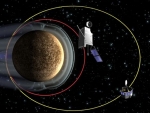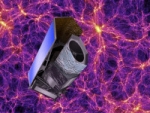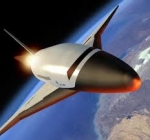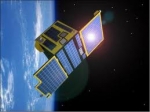Displaying items by tag: ESA
Gossamer Deorbiter Sail
Gossamer Deorbiter Sail: The purpose of this project is to develop a gossamer sail system that can be used for deorbiting satellites at end-of-life.
The principle that the system will use to achieve deorbiting is aerodynamic drag from the larger surface area. The system is intended mainly for low Earth orbit (LEO) telecom satellites but can potentially also be used in higher orbits, making use of solar radiation pressure to perform end-of-life manoeuvres.
A first demonstrator has been developed and tested by SSC in 2013 (see demonstrator page here).
Since there were many unfinished or failed attempts to prove that solar sailing is operational, ESA and DLR decided to start the collaborative Gossamer project. When all three steps of the Gossamer roadmap have successfully been completed, the solar sail propulsion will be declared operational and can be used in space mission. To ensure that Gossamer will not fail, ESA and DLR concentrate on a pure technological demonstrator mission with increasing complexity and level of difficulty in the three steps. Moreover, any scientific payload will be abandoned. It shall also be secured, that all Gossamer technologies are scalable. To avoid a failure in material or technologies, only those are used which have previously been proved and tested in numerous studies and projects. Finally, the Gossamer project and its technological success shall be perfectly documented and communicated to potential users.
The projected roadmap of DLR-ESA Gossamer contains three stages:
- Gossamer-1: launch in 2013: Demonstration of the safe deployment of a 5m x 5m solar sail in a 320km Earth orbit.
- Gossamer-2: launch in 2014: Deployment of a 20m x 20m solar sail in a 500km Earth orbit. Mass of 57 kg (inclusive margin) and container volume 50x50x60cm3 inside the rocking fairing. Test of a limited orbit and attitude control. The scheduled lifetime is about four weeks.
- Gossamer-3: launch in 2015: Deployment of a 50m x 50m solar sail in a > 10.000km Earth orbit. Mass of about 80kg and container volume 100x100x100cm3. Test of the full orbit and attitude control.
Sapienza sponsors XXXIII ESA Football Tournament
We are always happy to support sports and health related causes and the sponsorship of the XXXIII ESA Football Tournament fits within that philosophy.
Football teams from all ESA sites will compete between the 16th and 17th of June in Olbia, Sardinia, for the best ESA team title. Each year the yearly big event is organised in different ESA sites. This year the honour went to ESRIN.
Our Sapienza flag is also travelling to the event to support the teams during the weekend. May the best team win!
For more information visit the tournament’s Facebook page here.
ESA Harwell Centre
The ESA's Centre in Harwell is a research centre located in Oxfordshire, United Kingdom. Its focus is on three areas:
- ‘integrated applications’, which is the combined use of different space and terrestrial technologies, data and infrastructures to create new everyday applications;
- climate change modelling using data from space;
- and developing new technologies for the next era of planetary exploration, including robotics and innovative power sources that could be used on the Moon and Mars.
The Centre hosts the ESA Climate Office and also runs activities in the domains of Space Exploration. It supports the use of space technology in downstream domains through Integrated Applications, technology transfer activities and a Business Incubator.states.
The ESA research centre in the United Kingdom, opened on July 2009. It is based at the Harwell Science and Innovation Campus in Oxfordshire.
The ESA Harwell Centre is supporting as welll a Business Incubation Centre (BIC). It provides a unique opportunity for startup companies to access world class scientific facilities and research including that of the Diamond Light Source and STFC’s Rutherford Appleton Laboratory (RAL) – home to its internationally renowned space science department RAL Space, the world’s most powerful pulsed neutron source ISIS and the Central Laser Facility.
CSTS (Crew Space Transportation System)
CSTS (Crew Space Transportation System) or ACTS (Advanced Crew Transportation System) was a human spaceflight system proposal.
It was originally a joint project between the European Space Agency (ESA) and the Russian Space Agency (FKA), but is now solely an ESA project. It aims to design a spacecraft for low earth orbit operations such as servicing the International Space Station but also capable of exploration of the Moon and beyond. This study was conceived as a basic strategic plan to keep a viable European human space program alive when NASA officials announced the NASA's Vision for Space Exploration Orion spacecraft.
CSTS had completed an initial study phase, which lasted for 18 months from September 2006 to spring 2008, before the project was shut down before an ESA member state conference in November 2008.
BepiColombo
BepiColombo is Europe's first mission to Mercury.
It will set off in 2015 on a journey to the smallest and least explored terrestrial planet in our Solar System. When it arrives at Mercury in January 2022, it will endure temperatures in excess of 350 °C and gather data during its 1 year nominal mission, with a possible 1-year extension. The mission comprises two spacecraft: the Mercury Planetary Orbiter (MPO) and the Mercury Magnetospheric Orbiter (MMO). BepiColombo is a joint mission between ESA and the Japan Aerospace Exploration Agency (JAXA), executed under ESA leadership.
Euclid satellite
Euclid is an ESA mission selected for launch in 2019 in the Cosmic Vision 2015-2025 programme. The main goal of Euclid is to understand the origin of the accelerating expansion of the Universe. To achieve this, it is proposed to build a satellite equipped with a 1.2 m telescope and three imaging and spectroscopic instruments working in the visible and near-infrared wavelength domains.
The primary goall is to understand the nature of dark energy and dark matter by accurate measurement of the accelerated expansion of the Universe through different independent methods.
SpaceLiner
The SpaceLiner is a hypersonic suborbital spaceplane concept initiated by the German Aerospace Center (DLR) in 2005 and supported by the EU under the European Space Agency's (ESA) FAST 20XX program since December 2009.
The SpaceLiner is designed to be a reusable vehicle consisting of two stages: the booster and the space-plane itself. Both stages are propelled by LOx/LH2 rocket engines. The SpaceLiner lift-off is vertical (much like the Space Shuttle), powered by the combined thrust of the booster and the space-plane rocket engines. After the booster separation and engine cut-off, the space-plane behaves like a glider, skipping along the high layers of the atmosphere and ostensibly allowing for ultra-fast point-to-point travel. The SpaceLiner is designed to transport 50 passengers from Australia to Europe in 90 minutes or 100 passengers from Europe to California in 60 minutes.
Proba (satellite family)
PROBA (Project for On-Board Autonomy) is a family of small Earth observation satellites, part of the ESA's MicroSat program.
Proba-1 was launched by ISRO in 2001. It is a technology demonstrator turned operational Earth observation mission - ESA's smallest, less than a cubic metre in volume. Proba-1's main instrument is the Compact High Resolution Imaging Spectrometer (CHRIS), acquiring 13 square km scenes at 17 m spatial resolution in 18 user-selected visible and near-infrared wavelengths. This agile satellite can also deliver up to five different viewing angles. Nearly 20,000 environmental science images have been acquired. This small boxlike system (40×60×80 cm; 95 kg), with solar panel collectors on its surface, has remarkable image-making qualities. It hosts two Earth Observation instruments (dubbed CHRIS and HRC). It is a hyperspectral system (200 narrow bands) that image at 30 m, plus three in the visible that have 15 m resolution.
Proba-2, the second satellite in the Proba-series, has been launched on November 2, 2009, together with the SMOS mission. Proba 2 is a 0.6 × 0.6 × 0.8 meter, box-shaped structure weighing 130 kg with two deployable solar panels. It has a total of four instruments; two complementary solar observation instruments dubbed SWAP and LYRA, and two plasma measurement instruments dubbed TPMU and DSLP.
Further planned satellites in the Proba series are the formation flight Proba-3 and Proba-V (Proba Vegetation). They are on-going developments without defined launch dates.
Vitrociset S.p.A.
Vitrociset SPA is a group headquarted in Rome, Italy.
Vitrociset's activity in the space market dates back to 1982 with the awarding of a turnkey contract for the ESA (European Space Agency) Redu tracking station.
Now it has complete portfolio of products and services for key players of the space sector (ASI, CNES, Arianespace, MOD and Satellite Operators). This includes the design and development of mission-critical systems - an example of which is the development of essential components of the User Segment in the HELIOS mission, as well as of the SICRAL satellite communication system and the ESA Simulators and Control Centres.
The company is active:
- in the launch site of French Guyana
- in all operating centres of the ESA (ESOC, ESTEC, ESRIN) ; see Vitrociset Belgium
Projects, realizes and manages systems and services through value-for-money solutions able to provide quality and security based on the highest standards of innovation, in civil and military areas, for public administrations, government agencies, international organizations and private companies.
MOLTEK Consultants Ltd
MOLTEK is an international resourcing and consultancy organisation providing knowledge and resources in core skills to organisations within the Space, Defence, Aviation, Air traffic Management, Financial Service and Manufacturing industries. MOLTEK was formed in 1995, specifically to provide dedicated and focused consultancy. MOLTEK now has offices and subsidiaries in several countries, including the United Kingdom, the United States. Our services include consultancy, contract services, permanent recruitment, operations, facilities management and training.










